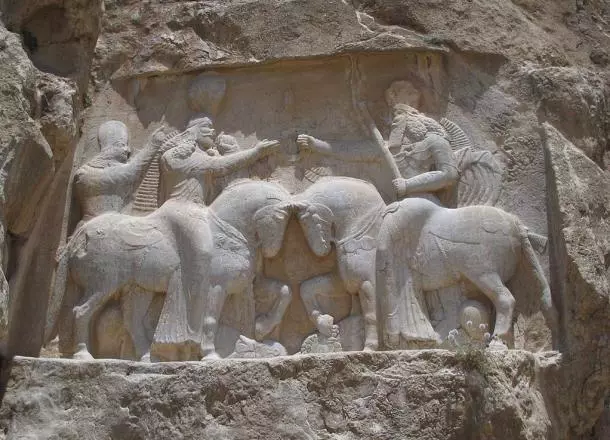Naqsh-e Rustam: Ancient Persian Tombs of Achaemenid Kings
Naqsh-e Rustam is one of the most spectacular and awe-inspiring ancient sites of the Achaemenid Empire, consisting of the colossal tombs of Persian kings dating back to the first millennium BC.
It stands as a lasting memory of a once powerful empire that ruled over a significant portion of the ancient world.
Naqsh-e Rustam (meaning Throne of Rustam ) is located approximately 5 km (3 miles) to the northwest of Persepolis, the capital of the former Achaemenid (Persian) Empire in present day in Iran.
Engraved on the façade of a mountain range considered sacred in the Elamite periods are the rock-cut tombs of Achaemenid rulers and their families dating to the 4 th and 5 th centuries BC, as well as richly decorated reliefs carved by the Sasanians in the 3 rd century AD. In addition to being a royal necropolis, Naqsh-e Rustam became a major ceremonial center for the Sasanians until the 7 th century AD.
The Naqsh-e Rustam site was already in use prior to the arrival of the Achaemenids, as evidenced in one pre-Achaemenid (possibly Elamite) relief and a number of old graves. Although this relief has been carved over by a Sasanian relief, a portrait of a man with a forward pointing hat and a long dress-like garment (clothing not typical of the Achaemenids and Sasanians) can still be discerned on the extreme right of the later relief.

According to some sources, it was this figure that locals associated with the mythical hero of the Shahnameh writings in the “book of the kings”, named Rustam, hence the name of the site.
Most of the reliefs, however, date to beginning of the Sasanian period. In the 3 rd century AD, the Sasanians, a vassal of the Parthian Empire that succeeded in overthrowing its master, were a new power that rose in the East. In order to legitimize their rule, the Sasanians sought to associate themselves with the Achaemenid (Persian) Empire, and regarded themselves as its direct successors. One of the things they did to achieve this goal was to carve reliefs at Naqsh-e Rustam.

While the site itself does not yet have UNESCO World Heritage status, the Sasanian relief carvings are protected as part of the “ Sassanid Archaeological Landscape of Fars Region ”, recognized by UNESCO for embodying the political, historical, cultural and artistic developments of the mighty Sasanian Empire. The newly UNESCO-registered ensemble, as of July 2018, is comprised of eight archaeological sites situated in three geographical parts of Firuzabad, Bishapur and Sarvestan.
Two other local names for Naqsh-e Rustam are Salib, an Arabic word meaning ‘cross’, and the Persian Crosses. This is due to the façade of the tombs, which resembles crosses. It was the tombs, which belonged to the Achaemenids that attracted the Sasanians to Naqsh-e Rustam. These tombs are burial chambers carved into the side of the hill rock, and each contained a sarcophagus. It is unclear, however, whether the bodies were placed directly into these sarcophagi, or the bones interred in them after being exposed on a ‘tower of silence’. Furthermore, it is believed that all the tombs were looted and desecrated following the invasion of Alexander the Great during the 4 th century BC.

Although there are four tombs, only one of them can be identified with certainty, as it is accompanied by a trilingual inscription. This is the tomb of Darius I, the third ruler of the Achaemenid Empire. Above the cross façade of Darius’ tomb is a panel with a relief. The relief depicts Darius, whose hands are raised in a gesture of worship, standing on a three-stepped pedestal in front of an altar. The king’s piety accords him divine protection, as the winged disc of Ahuramazda (the god of the Zoroastrian faith), is shown floating above his head. The relief also proclaims the might of the Achaemenid Empire, as the entire scene is supported by throne bearers representing the 28 nations under the empire.
The other three tombs at Naqsh-e Rustam are thought to belong to Darius’ successors, Xerxes I, Artaxerxes I and Darius II. This is based on the fact that the layout of these tombs is copied from the tomb of Darius. Without any inscriptions or additional evidence, the identities of the tomb owners may remain merely as speculation. Other royal tombs of a similar form can be found in Persepolis. These tombs, cut into the rock face at Kuh-i Rahmat, are thought to belong to the later Achaemenid rulers, and demonstrate of the influence exerted by the tombs at Naqsh-e Rustam.


After the fall of the Achaemenid Empire, no new tombs were made at Naqsh-e Rustam. As mentioned earlier, the Sasanians attempted to make a connection with the Achaemenids by carving reliefs on the rock walls of Naqsh-e Rustam. The subjects of the reliefs are varied, and were carved over between the 3 rd and early 4 th centuries AD by different Sasanian rulers. One of the most famous reliefs is that of Shapur I’s victory over the Roman emperors Gordian III, Valerian and Philip the Arab. Other reliefs include the investiture of Ardashir I (the first relief to be carved at the site), and the equestrian relief of Hormizd II (the last relief to be carved).
Plans are underway to include the whole site of Naqsh-e Rostam on the UNESCO World Heritage list by incorporating it into the adjacent Persepolis, which already has World Heritage status. As part of this process, several restoration projects are underway. Detailed laser scanning of the site is underway to support exact restoration.





